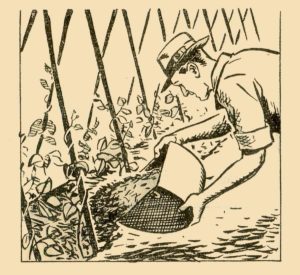Are you watching out for those pests?
Any signs of black fly yet ? Some gardeners think that this pest is encouraged by broad beans, but there is no foundation for this. You may quite likely find it on your “runners.”
Wherever you come across it, take the measures recommended on pages 7 and 8 of the April Guide. And if you are growing broad beans, remove the growing tips when the plants are in full flower. If the winds are high and the plants look like being broken, put in a few stout stakes and run some stout string around the rows.
While the April Guide deals with other garden pests that may be a nuisance in June (slugs on your lettuce, cabbage root fly and carrot fly), it may not cover some pests that may trouble you. Celery fly for instance. Brown blisters may appear on the leaves. Watch the seedlings carefully for blistered leaves, and destroy them or crush them with your fingers. Dust the plants weekly with soot to prevent egg laying. If the attack is serious, spray the leaves (both sides) with a nicotine and soap wash.
Then onion fly may also cause trouble, especially on dry soils. As a precaution dust the soil along each side of the rows with 4 per cent. Calomel when the plants are about an inch high.
Both nicotine (a strong, indiscriminate poison) and Calomel are banned nowadays. I’m sure there’s a good reason not to use chimney coal soot on the plants as well.
Feed your CROPS
Beet, carrots, parsnips and onions benefit by a dressing of sulphate of ammonia after thinning— ½ oz. to the yard run. If your carrots and onions are attacked by the fly, a similar dressing will help them considerably.
LETTUCE
Don’t forget to sow a short row of seed every fortnight to ensure a succession. And if you transplant the thinnings from earlier rows, see that you give them a good start. Don’t put them on lumpy ground and don’t water them late on a cold evening or leave them without water at all. If the plot reserved for lettuce is lumpy and not easy to break down to a fine tilth;, sift some fine soil over the surface, see that the seedlings are firmly planted and watered well at the right time until they are firmly established.
MARROWS
Although marrows are usually sown in the open towards the end of May, it’s not too late to sow in June. In a sunny corner dig in some well-rotted manure or compost and set a few groups of seed—four or five seeds to each group—about 6 in. apart and 1 in. deep. Later, thin each group to two plants, 12 to 15 in. apart. Marrows need a lot of water. Make sure they get it, particularly in dry weather.
Couple of Tips
 First, as to cabbages : when you cut one, make two nicks crosswise on the top of the stump, and within a month or six weeks it will sprout again and give you a crop of tender greens.
First, as to cabbages : when you cut one, make two nicks crosswise on the top of the stump, and within a month or six weeks it will sprout again and give you a crop of tender greens.
Second, if you have any grass left in your garden and are not using the mowings to feed stock or make compost, give your runner beans a mulch of 2 or 3 inches. This will help to conserve the moisture and benefit the beans considerably.


